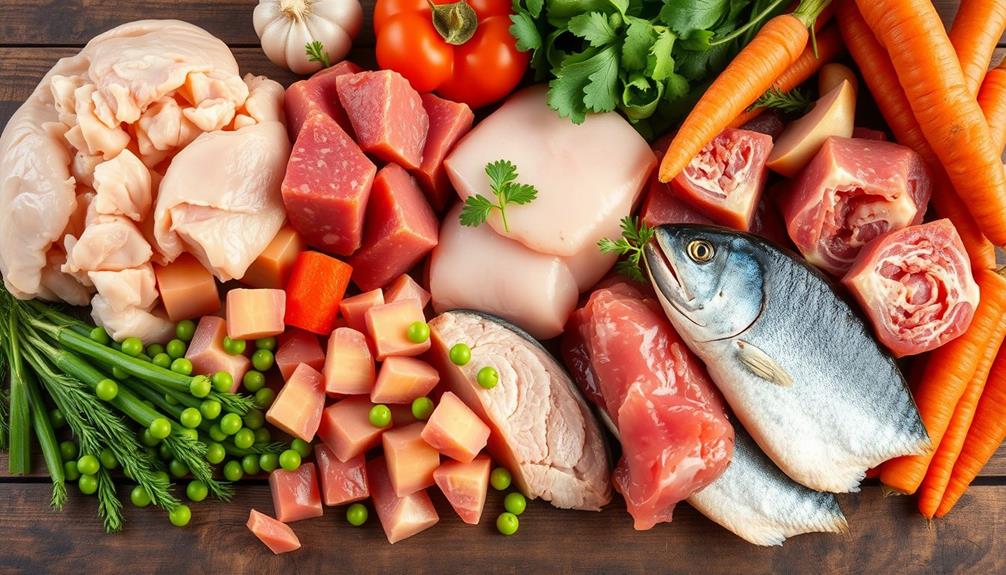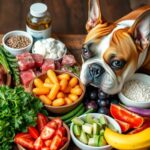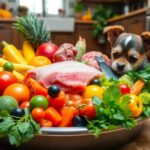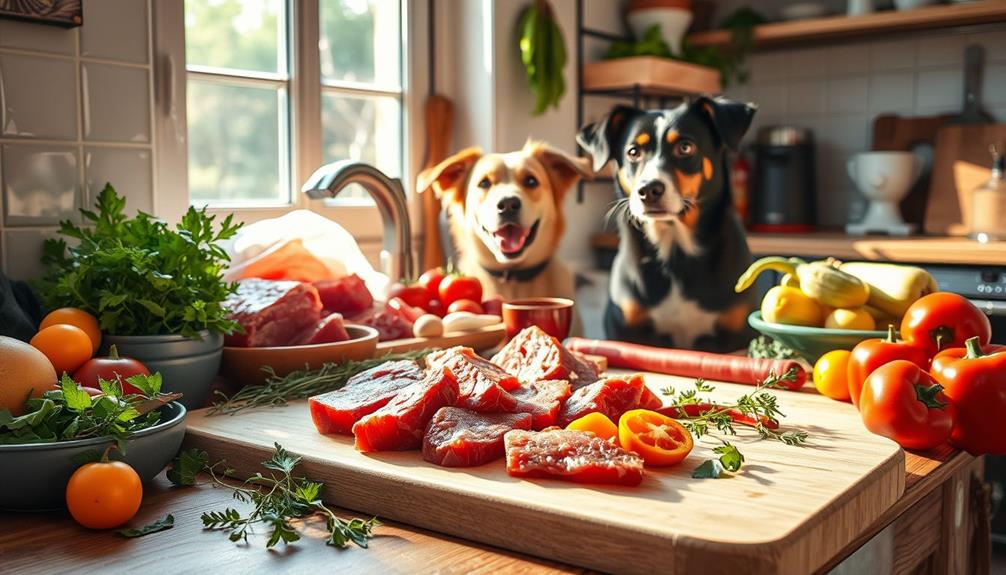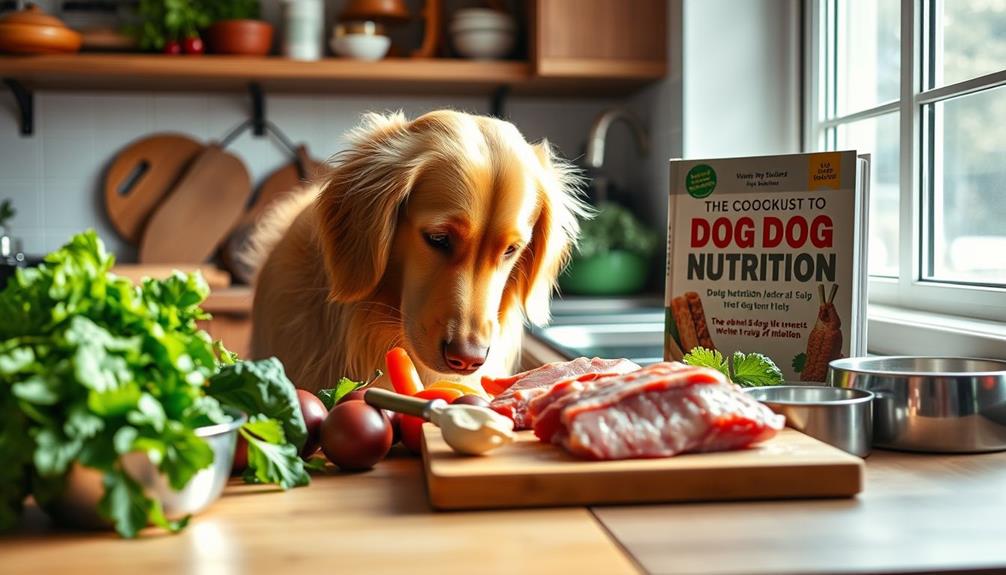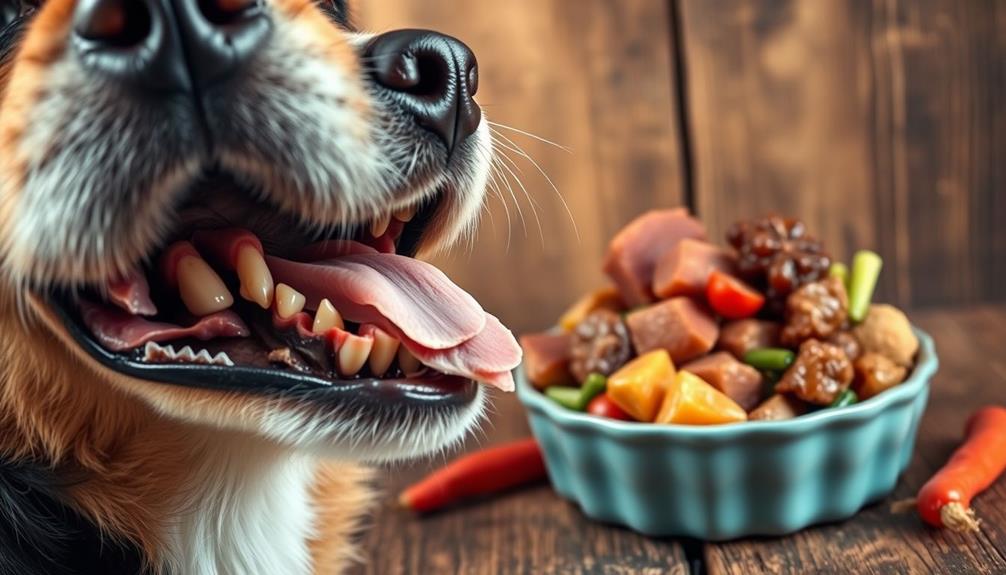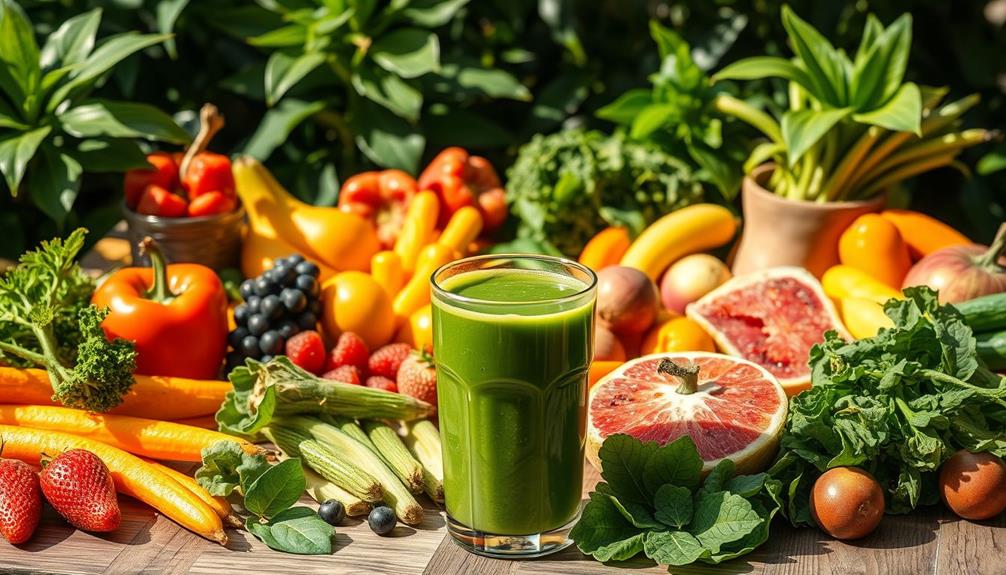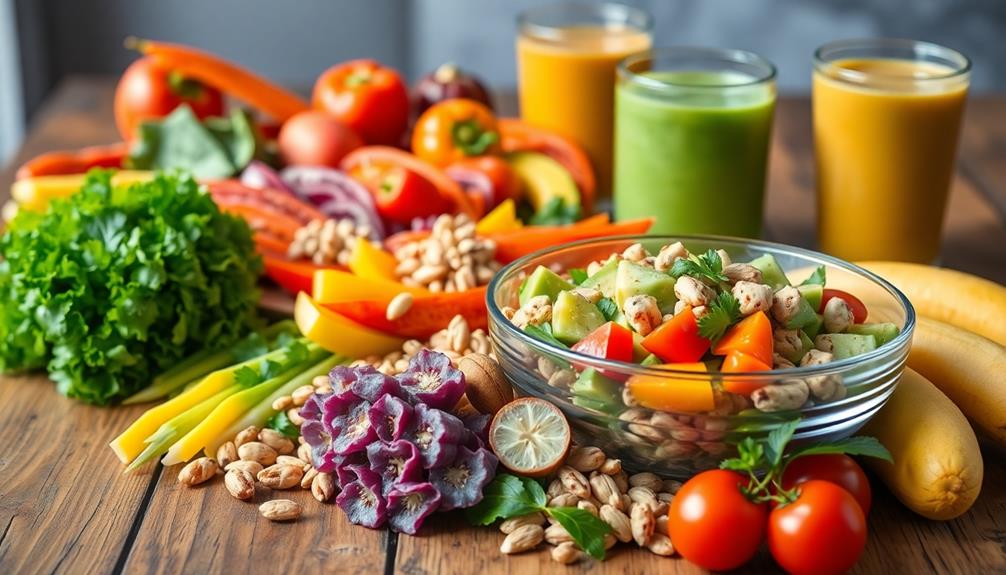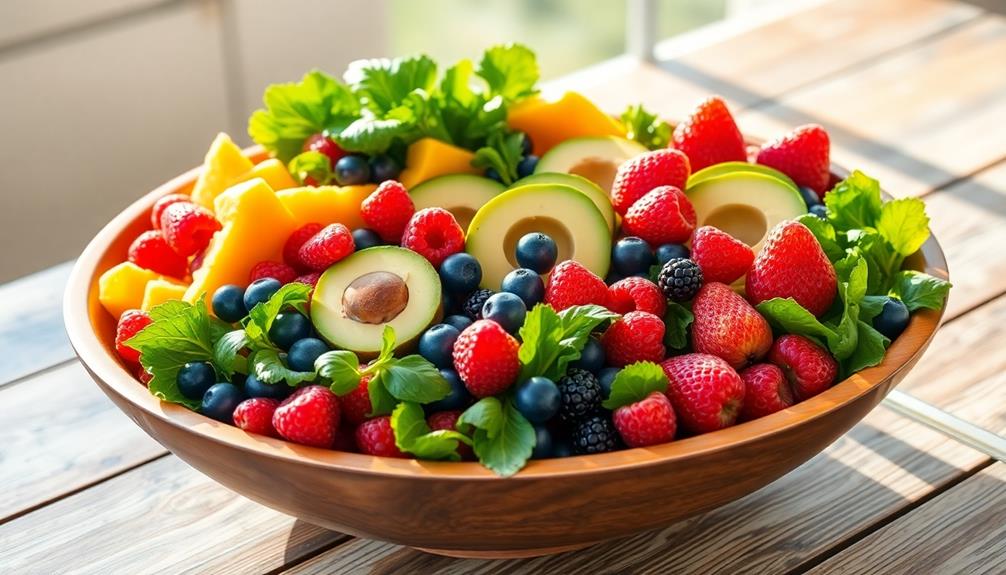You can feed your cat a variety of raw foods like chicken, turkey, and beef, which provide essential proteins and nutrients. Raw muscle meat, organ meat, and ground bones are key components of a balanced raw diet. Always focus on freshness and make sure the meat is boneless to prevent choking. Be cautious of potential bacterial contamination and practice good hygiene when handling raw meat. Shift your cat gradually to prevent digestive issues. A well-rounded approach is vital for your cat's health and well-being, and there's plenty more to explore about guaranteeing a safe and nutritious raw food diet. One way to ensure a safe raw food diet for your cat is by consulting with a vet or animal nutritionist who specializes in feeding raw food to cats. They can provide guidance on the proper balance of proteins, fats, and other essential nutrients to meet your cat’s dietary needs. Additionally, researching reputable sources and brands of raw cat food can also help you make informed choices when it comes to feeding raw food to cats.
Key Takeaways
- Offer raw muscle meats like chicken and turkey, ensuring they are fresh and boneless for optimal nutrition.
- Incorporate organ meats such as liver to provide essential vitamins and nutrients vital for your cat's health.
- Include ground bones in the diet to supply calcium and promote dental health through natural chewing.
- Fish can be given in moderation for omega-3 fatty acids, but avoid overfeeding to prevent nutrient imbalances.
- Gradually introduce new proteins to monitor your cat's reactions and ensure a balanced intake of essential nutrients.
Understanding Raw Food Diets
Raw food diets (RFDs) for cats often consist of three main components: raw muscle meat, organ meat, and ground bones. As obligate carnivores, cats require a diet rich in protein to meet their nutritional needs.
While some cat owners believe that a raw food diet provides superior nutrition compared to traditional kibble, the reality is more complex. Scientific evidence suggests that cooking can actually enhance nutrient digestibility, making raw meat potentially less beneficial for your feline friend.
Additionally, it's important to take into account the overall diet and the necessity of providing a variety of nutrients, as seen in proper hamster care which emphasizes balanced nutrition.
It's essential to understand that homemade raw diets often lack nutritional adequacy unless formulated properly. As a result, you should consult your veterinarian before making any changes to your cat's diet. They can guide you on how to create a balanced raw food diet or recommend commercially prepared options that meet your cat's needs.
Be aware of the health risks associated with feeding raw diets, like the potential for bacterial contamination from pathogens such as Salmonella and E. coli.
Moreover, feeding unground bones can lead to serious intestinal blockages. Given these concerns, many experts and organizations, including the CDC and AVMA, generally advise against raw food diets for cats.
Benefits of Raw Food for Cats
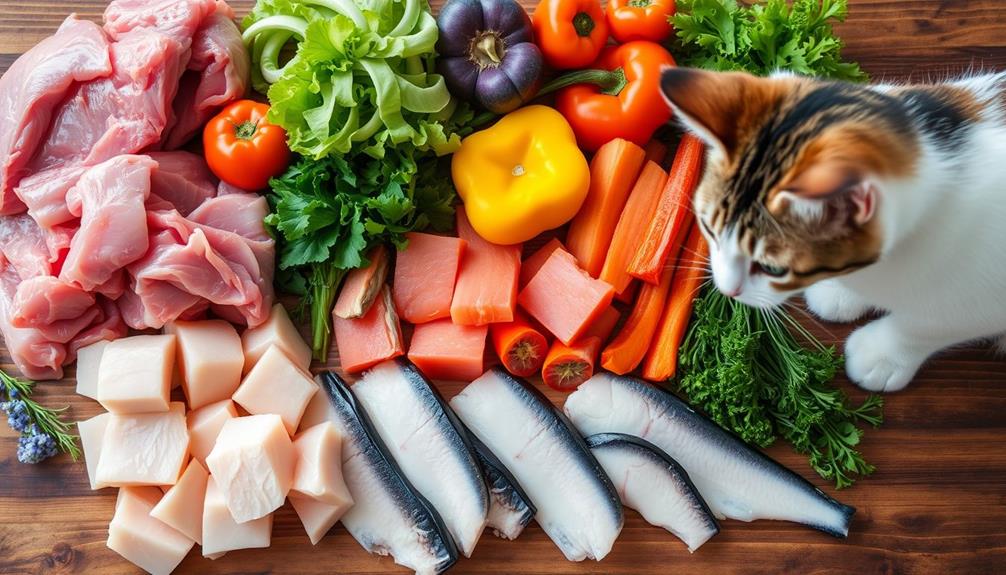
When you switch your cat to a raw food diet, you're giving them a boost in essential nutrients and high-quality protein that supports their overall health.
This change can also lead to better digestive health, as raw diets often promote easier digestion.
Additionally, incorporating a variety of meats can provide your cat with important vitamins and minerals.
As a result, you might notice your cat feeling more energetic and vibrant than ever before.
Nutritional Advantages of Raw
The nutritional advantages of a raw food diet for cats are significant, offering a range of benefits that cater to their unique dietary needs. By incorporating raw food into your cat's diet, you enhance their nutritional value and support their overall health. Raw meat is packed with high-quality protein and essential fatty acids, essential for maintaining critical functions.
| Benefit | Description |
|---|---|
| Essential Amino Acids | Contains essential nutrients like taurine for heart and eye health, which cats can't synthesize. |
| Improved Skin and Coat | Rich in omega-3 and omega-6 fatty acids that promote a healthy, shiny coat and reduce shedding. |
| Alignment with Natural Diet | Matches the dietary needs of obligate carnivores, ensuring your cat gets species-specific nutrition. |
Feeding your cat raw can also promote natural chewing behaviors, contributing to better oral health by reducing plaque buildup. By understanding these nutritional advantages, you can make informed choices that enhance your cat's diet and support their long-term well-being.
Improved Digestive Health
Incorporating raw food into your cat's diet can markedly improve their digestive health. A raw diet, rich in raw meat, provides higher moisture content and natural enzymes that aid in breaking down food. This means your cat may experience improved digestion and better nutrient absorption since some nutrients are more bioavailable in their raw form compared to cooked options.
Additionally, a well-structured budget for your pet's food can help you manage costs effectively while ensuring high-quality nutrition for your cat, aligning with financial health principles.
You'll likely notice a reduction in litter box odor and volume, which indicates that your cat is utilizing nutrients more effectively. This improved digestion is essential for their overall well-being.
Additionally, a raw food diet is high in protein and low in carbohydrates, aligning with your cat's natural dietary needs and helping to alleviate digestive issues often caused by high-carb commercial diets.
Another benefit of feeding raw food is the positive impact on your cat's oral health. Chewing on raw meat and bones can naturally clean their teeth and gums, contributing further to their overall health.
Ensuring Balanced Nutrition
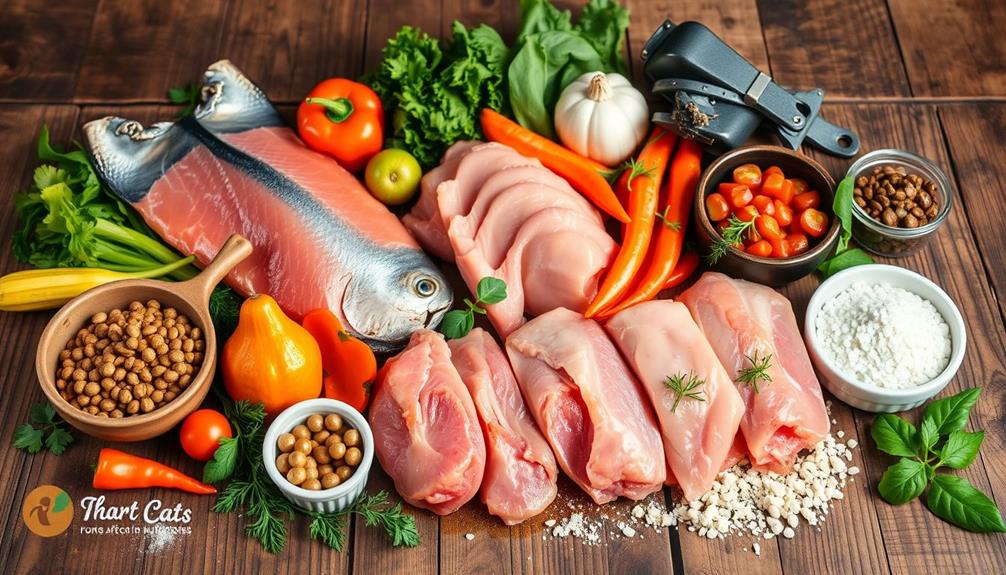
Guaranteeing balanced nutrition in a raw food diet for your cat requires careful attention to the variety of ingredients you include. A well-rounded raw diet should consist of raw muscle meat, organ meat, and ground bones. These components provide the essential nutrients your cat needs, such as taurine, arachidonic acid, and vitamin A, all of which are critical for their health.
Additionally, understanding the importance of financial considerations for elderly care can also apply to pet care, as budgeting for your cat's nutritional needs is fundamental. While you might consider creating a homemade raw diet, it's important to remember that these often lack significant vitamins and minerals. To avoid nutritional deficiencies, consult with a veterinarian or a veterinary nutritionist when formulating your cat's raw food plan. They can guide you on how to achieve balanced nutrition effectively.
Alternatively, commercially prepared raw diets can be a great option since they're designed to meet the nutritional requirements set by organizations like WSAVA. Regular health check-ups and monitoring your cat's condition are fundamental to guarantee their raw diet remains nutritionally adequate.
Safety Concerns With Raw Diets
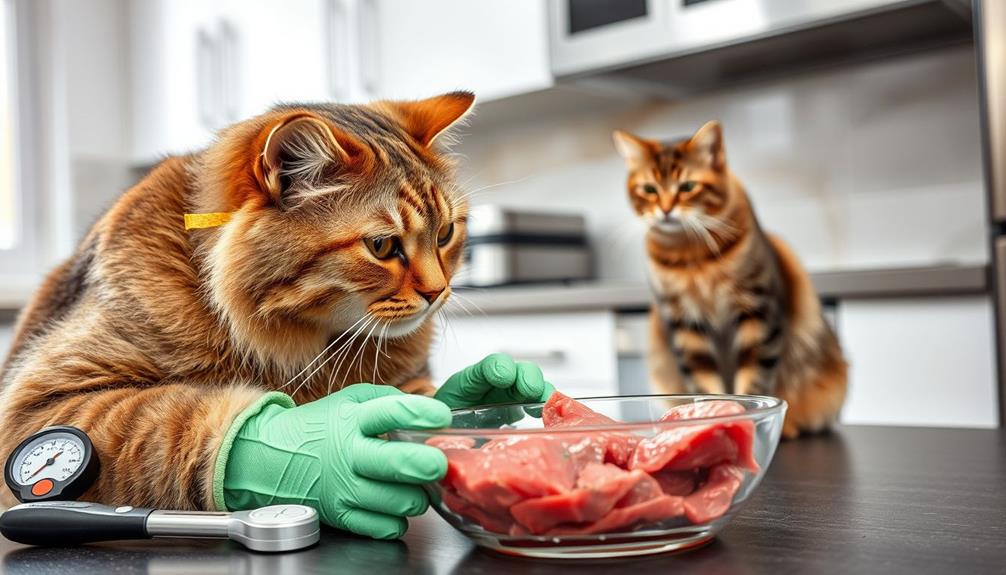
When you consider a raw diet for your cat, it's vital to be aware of the potential risks.
Bacterial contamination from raw meat can harm both your pet and your household, while improper meal prep might lead to nutritional imbalances.
It's important to incorporate effective strategies for weight loss to guarantee your cat maintains a healthy weight.
Always consult with your vet to navigate these safety concerns effectively.
Bacterial Contamination Risks
Feeding your cat a raw diet can come with significant bacterial contamination risks that you need to be aware of.
Raw meat can harbor harmful bacteria like Salmonella and E. coli, which pose serious health risks to both your feline friend and your household.
Even though cats have short, acidic stomachs that may help reduce bacterial infection risks, improper handling during preparation can lead to cross-contamination.
It's crucial to maintain proper hygiene practices, similar to those used in commercial settings like preventing cross-contact in kitchens.
Here are three key safety tips to keep in mind:
- Safe Handling: Always wash your hands, surfaces, and utensils after touching raw meat to avoid bacterial contamination.
- Storage: Store raw meat properly in sealed containers and refrigerate or freeze it immediately to minimize the risk of foodborne illnesses.
- Vet Consultations: Regularly consult with your vet to guarantee you're following safe practices and addressing any health concerns that may arise from feeding raw diets.
Nutritional Imbalance Concerns
Many cat owners may not realize that feeding a raw diet can lead to nutritional imbalances that jeopardize their pet's health. Homemade raw diets often lack essential nutrients, such as thiamine, which is critical for nerve and brain function. Without proper formulation, these diets may not provide sufficient levels of important vitamins and minerals, resulting in health issues like poor coat quality, lethargy, and a weakened immune system.
To help you understand the risks, here's a quick overview:
| Nutritional Imbalance | Potential Consequences | Recommended Solution |
|---|---|---|
| Thiamine Deficiency | Neurological issues | Consider commercially prepared raw diets |
| Vitamin A Deficiency | Vision problems | Regular vet consultations |
| Calcium Deficiency | Bone health issues | Balanced homemade recipes |
Regular veterinary consultations are necessary when you choose to feed a raw diet. They can help you monitor for potential health issues arising from nutritional deficiencies. While commercially prepared raw diets are more likely to be balanced and complete, homemade versions need careful planning to guarantee your cat gets everything it needs to thrive.
Transitioning Your Cat to Raw
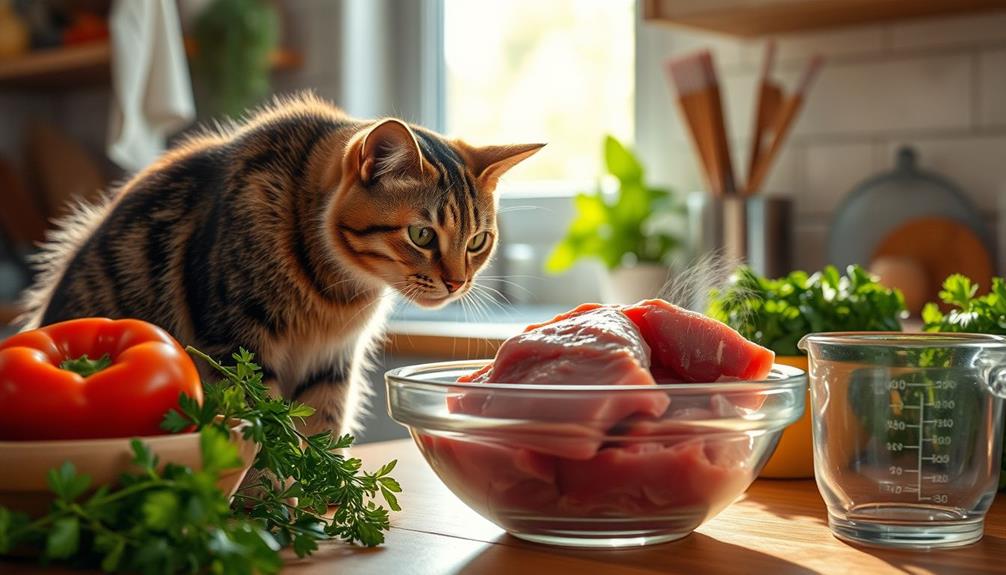
Shifting your cat to a raw food diet can be a rewarding journey, but it requires a careful and gradual approach. To make the change to a raw diet smoother, follow these steps: It's important to take into account your cat's overall developmental needs during this shift, as their health can be influenced by dietary changes.
- Start Slow: Begin by mixing 25% raw food with 75% of their current diet. Gradually introduce raw food by increasing the raw portion by 25% every 2-3 days. This helps prevent digestive upset.
- Monitor Health: Keep an eye on your cat's health throughout the process. Watch for any signs of discomfort or digestive issues, and don't hesitate to consult with a veterinarian if you have any concerns.
- Be Patient: Some cats need more time to adapt to feeding raw food. If your cat shows picky eating habits, be flexible and try different strategies to encourage them.
Starting the shift after your cat is 20 weeks old can also ease the process, as younger cats tend to adapt better.
Suitable Raw Meats for Cats
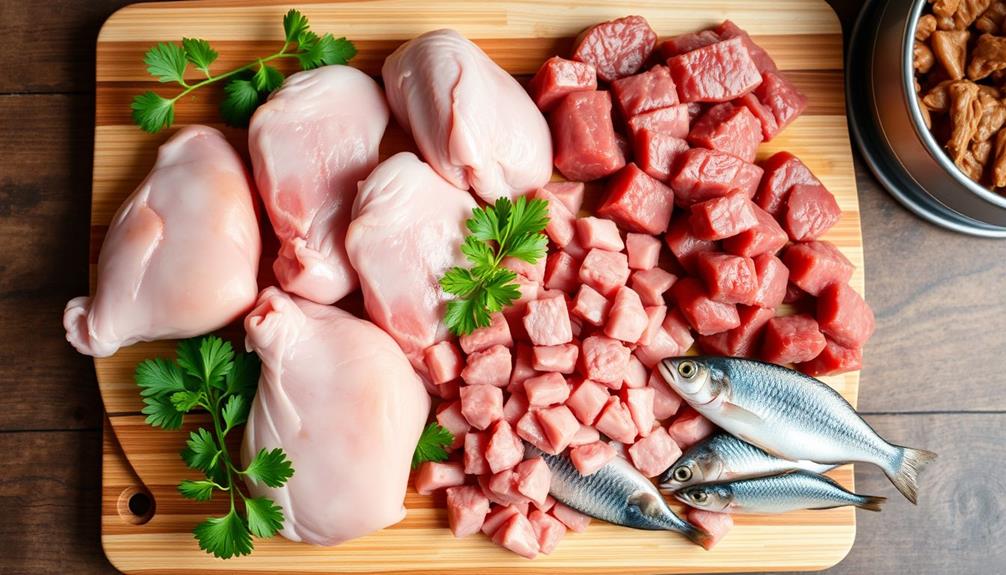
As you explore raw food options for your cat, selecting the right meats is key to providing balanced nutrition. Here's a quick overview of suitable raw meats that can enhance your cat's diet while supporting their immune system and overall health.
| Meat | Benefits | Considerations |
|---|---|---|
| Chicken | Low in fat, high in protein, rich in Omega-6 and taurine | Confirm it's fresh and boneless |
| Turkey | Lean protein, supports eyesight and digestion | Always check for allergens |
| Beef | Rich in protein and essential vitamins (iron) | Choose lean cuts to avoid excess fat |
| Fish | High in omega-3 fatty acids for skin and coat health | Offer in moderation to prevent imbalances |
Incorporating these suitable raw meats into your cat's diet can provide vital nutrients that promote muscle development and heart health. Always remember to introduce new proteins gradually and monitor how your cat reacts to each type of meat. Feeding raw cat food can be rewarding, but it's crucial to guarantee a balanced approach to maintain their health.
Alternatives to Raw Feeding
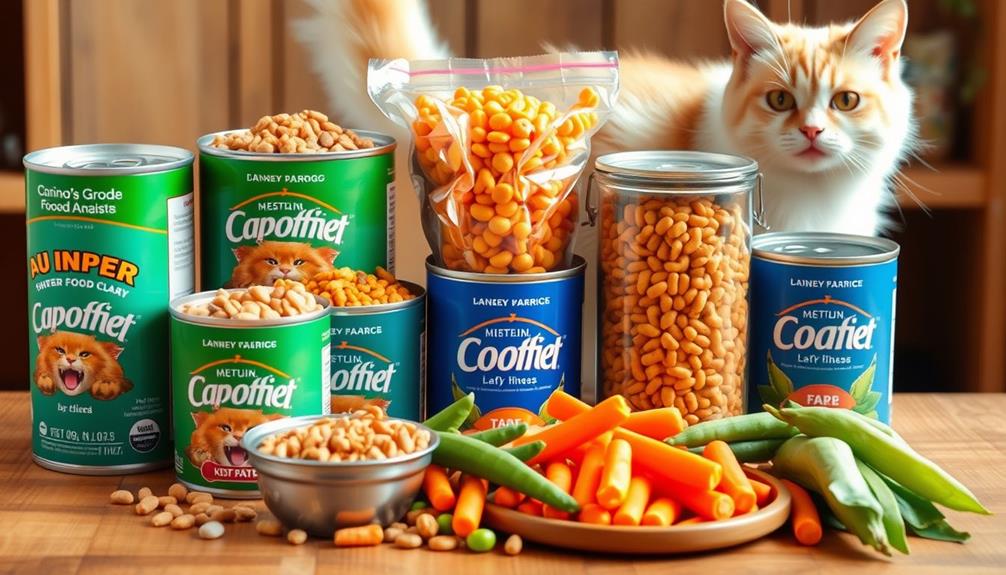
When considering feeding your cat, there are several excellent alternatives to raw feeding that can still provide balanced nutrition. Here are three options you might find suitable:
1. Cooked Meat Options: Steamed or boiled chicken is a safe and nutritious choice. These cooked meat options are free from the risks of bacterial contamination while still delivering essential nutrients.
Additionally, just like investing in precious metals, guaranteeing a balanced diet can provide long-term health benefits for your pet, making it a worthwhile consideration for any cat owner looking for trusted advice.
2. Freeze-Dried Raw Diets: If you want the benefits of raw meat without the hazards, freeze-dried raw diets are a great alternative. They maintain the nutritional qualities of raw food while eliminating harmful pathogens, making them a convenient choice for you.
3. High-Quality Canned Food: This option offers moisture and essential nutrients, serving as a balanced alternative to raw diets. Look for high-quality canned food that meets your cat's dietary needs.
You might also consider dry cat food, or kibble, which is specially formulated to meet your cat's nutritional requirements and offers convenience.
Frequently Asked Questions
What Raw Foods Are Good for Cats?
When considering what raw foods are good for your cat, focus on fresh meats like chicken and turkey, organ meats for nutrients, and occasional fish. Just avoid anything seasoned or with harmful additives.
Is Raw Feeding Safe for Cats?
You need to be cautious with raw feeding for cats. It can pose health risks from bacteria and nutritional imbalances. Always consult your vet before making any changes to your cat's diet for safety.
How to Introduce a Cat to a Raw Diet?
To introduce your cat to a raw diet, start gradually. Mix 25% raw with their current food, increasing the raw portion every few days. Monitor their health and adjust as needed for a smooth shift.
Can I Feed My Cat Raw Meat From the Grocery Store?
Sure, you can feed your cat raw meat from the grocery store, but make certain it's sourced safely. Always freeze it first, handle it carefully, and consult your vet to ascertain it's balanced and safe.
Conclusion
Feeding your cat a raw food diet can be a rewarding journey, offering both health benefits and a deeper bond with your furry friend. However, balancing nutrition and ensuring safety is essential. While the allure of fresh, natural meals is strong, the risks of bacteria and improper nutrition shouldn't be overlooked. By carefully weighing both sides, you can make informed choices that enrich your cat's life while keeping their health at the forefront. Remember, balance is key.

